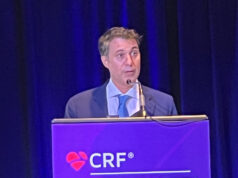
Early improvement in health status for patients in the COAPT trial who had transcatheter mitral valve repair (TMVr) with the MitraClip (Abbott) was strongly associated with reduced long-term risk of death or heart failure hospitalisation.
COAPT investigators Suzanne V Arnold (Saint Luke’s Mid America Heart Institute, and University of Missouri, Kansas City, USA) et al write in the Journal of the American College of Cardiology: “These findings reinforce the prognostic utility of serial KCCQ-OS [Kansas City Cardiomyopathy Questionnaire-overall summary] assessments to identify patients at risk for poor long-term clinical outcomes in this population.”
The research was due to be presented at the American College of Cardiology’s Scientific Session Together with World Congress of Cardiology (ACC.20/WCC; Chicago, USA), scheduled to take place 28–30 March, but which has now been cancelled due to the coronavirus outbreak.
COAPT (Cardiovascular outcomes assessment of the MitraClip percutaneous therapy for heart failure patients with functional mitral regurgitation) found that TMVr with the MitraClip rapidly improved health status and reduced the long-term risks of death and heart failure (HF) hospitalisation in patients with HF and severe secondary mitral regurgitation (SMR) who remained symptomatic despite guideline directed medical therapy (GDMT). Arnold and colleagues examined the association between short-term changes in health status and the subsequent risk of HF hospitalisation or death in patients enrolled in COAPT. They also sought to examine whether there was a differential association between change in early health status and subsequent outcomes based on treatment assignment (TMVr vs. standard care).
They explain: “If change in health status at one month were found to be an independent long-term prognostic factor, this knowledge would provide important information at the time of early follow-up. Identifying patients at high risk patients for poor outcomes at this timepoint could permit further efforts to improve long-term outcomes, such as referral for advanced HF therapies.”
The researchers evaluated the association between change in health status (KCCQ-OS) from baseline to one month and the composite rate of death or HF hospitalisation between one month and two years in the COAPT trial, and tested whether treatment (TMVr or GDMT alone) modified this association.
They found that, among 551 patients with HF and severe SMR who were alive at one month, those randomised to TMVr were more likely than GDMT alone to achieve a ≥10-point improvement in KCCQ-OS from baseline to one month (58% TMVr vs. 26% GDMT alone). Early improvement in KCCQ-OS was inversely associated with the risk of death or HF hospitalisation between one month and two years (p<0.001). When analysed as a continuous variable, a 10-point increase in KCCQ-OS was associated with a 14% lower risk of death or HF hospitalisation (hazard ratio [HR] 0.86, 95% confidence interval [CI] 0.81–0.92, p<0.001), with no significant interaction with treatment group (pinteraction=0.17). After adjusting for demographic and clinical factors, the association between change in KCCQ-OS and outcomes was strengthened (HR 0.79, 95% CI 0.73–0.86, p<0.001).
Describing the KCCQ as “a particularly powerful strategy to improve outcomes”, the authors say the findings suggest it may be considered “not only an important patient-centred outcome for patients with HF and severe secondary MR but also a valuable signal for guiding therapy”, that could “trigger consideration of other advanced HF therapies, such as left ventricular assist device or cardiac transplantation”.
Arnold et al propose a care pathway in which “the first step should be medical optimisation. If the clinical response (as measured by the KCCQ) is not sufficient (or durable) and the patient has appropriate anatomy, the next step should be TMVr. If this does not result in significant improvement in the KCCQ, consideration may then be given to advanced HF therapies or, if the patient is not a candidate for these approaches, palliative care.”
They say further research is needed to understand how health status data can be incorporated into clinical decision-making after TMVr and other heart failure therapies in order to maximise patients’ long-term outcomes.










